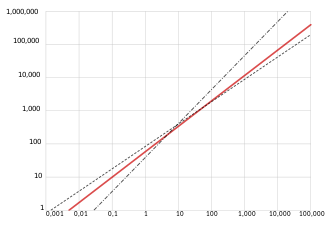
Kleiber's law, named after Max Kleiber for his biology work in the early 1930s, is the observation that, for the vast majority of animals, an animal's metabolic rate scales to the 3⁄4 power of the animal's mass.[2] More recently, Kleiber's law has also been shown to apply in plants,[3] suggesting that Kleiber's observation is much more general. Symbolically: if B is the animal's metabolic rate, and M is the animal's mass, then Kleiber's law states that . Thus, over the same time span, a cat having a mass 100 times that of a mouse will consume only about 32 times the energy the mouse uses.
The exact value of the exponent in Kleiber's law is unclear, in part because the law currently lacks a single theoretical explanation that is entirely satisfactory.
- ^ Kleiber M (October 1947). "Body size and metabolic rate". Physiological Reviews. 27 (4): 511–41. doi:10.1152/physrev.1947.27.4.511. PMID 20267758.
- ^ Kleiber M (January 1932). "Body size and metabolism". Hilgardia. 6 (11): 315–353. doi:10.3733/hilg.v06n11p315.
- ^ Enquist BJ, Brown JH, West GB (1998). "Allometric scaling of plant energetics and population density". Nature. 395 (10): 163–165. Bibcode:1998Natur.395..163E. doi:10.1038/25977.
